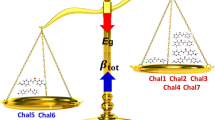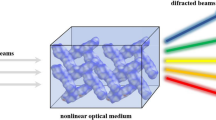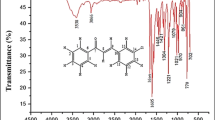Abstract
Using the state-of-art computational techniques, we limelight a structure–property relationship for the position and number of methoxy group(s) to tune the optical and nonlinear optical (NLO) properties (first hyperpolarizability) of chalcone derivatives. Based on our previously synthesized chalcones [system 1 ((E)-1-(2,5-dimethylthiophen-3-yl)-3-(2-methoxyphenyl)prop-2-en-1-one and system 4 (E)-1-(2,5-dimethylthiophen-3-yl)-3-(2,4,5-trimethoxyphenyl)prop-2-en-1-one)], we systematically design several novel derivatives with tuned optical and NLO properties. For instance, the rotation of methoxy group substitutions at three different possible ortho, meta, and para positions on phenyl ring show significant changes in NLO properties of these chalcones derivatives. The system 3 has shown β tot amplitude of 1776 a.u. with terminal 4-methoxyphenyl group (para-methoxy substitution), which is ~2.2 and 2.4 times larger than that of ortho- and meta-methoxyphenyl systems 1 and 2, respectively. Additionally, systems 3a and 4a, which are cyano derivatives of the systems 3 and 4 show significantly large β tot amplitudes of 3280 and 4388 a.u., respectively, which are about 3 and 4 times larger than that of para-nitro aniline (PNA) molecule (a typical donor-acceptor molecule) at the same LC-wPBE/6-311G** level of theory. The origin of larger β tot amplitudes has been traced in lower transition energies and higher oscillator strengths for crucial transitions of designed derives. Thus, our investigation reveals that the chalcones derivatives with para-methoxyphenyl groups possess reasonably large amplitudes of their first hyperpolarizability and good optical transparency (3.0−4.7 eV), which can make them attractive candidates for nonlinear optical applications.

The impact of position and number of methoxy group(s) to tune the nonlinear optical properties of chalcone derivatives






Similar content being viewed by others
References
Hadfield RH (2009) Single-photon detectors for optical quantum information applications. Nat Photonics 3(12):696–705
Papadopoulos MG, Sadlej AJ, Leszczynski J (2006) Non-linear optical properties of matter. Springer, Heidelberg
Kurtz HA, Stewart JJP, Dieter KM (1990) Calculation of the nonlinear optical properties of molecules. J Comput Chem 11(1):82–87. doi:10.1002/jcc.540110110
Mohd Shkir SMSA (2015) Experimental and density functional theory (DFT): a dual approach to study the various important properties of monohydrated l-proline cadmium chloride for nonlinear optical applications. Spectrochim Acta A Mol Biomol Spectrosc 143:128–135
Muhammad S, Irfan A, Shkir M, Chaudhry AR, Kalam A, AlFaify S, Al‐Sehemi AG, Al‐Salami AE, Yahia IS, Xu HL (2015) How does hybrid bridging core modification enhance the nonlinear optical properties in donor‐π‐acceptor configuration? A case study of dinitrophenol derivatives. J Comput Chem 36(2):118–128
Muhammad S, Nakano M (2013) Computational strategies for nonlinear optical properties of carbon nano-systems. Nanosci Comput Chem: Res Prog p 309
Xu H-L, Li Z-R, Su Z-M, Muhammad S, Gu FL, Harigaya K (2009) Knot-isomers of Mobius cyclacene: how does the number of knots influence the structure and first hyperpolarizability? J Phys Chem C 113(34):15380–15383
Muhammad S, Xu H-L, Zhong R-L, Su Z-M, Al-Sehemi AG, Irfan A (2013) Quantum chemical design of nonlinear optical materials by sp 2-hybridized carbon nanomaterials: issues and opportunities. J Mater Chem C 1(35):5439–5449
Bosshard C, Hulliger J, Florsheimer M, Gunter P (2001) Organic nonlinear optical materials. CRC, Boca Raton
Shkir M, AlFaify S, Abbas H, Muhammad S (2015) First principal studies of spectroscopic (IR and Raman, UV–visible), molecular structure, linear and nonlinear optical properties of l-arginine p-nitrobenzoate monohydrate (LANB): a new non-centrosymmetric material. Spectrochim Acta A Mol Biomol Spectrosc 147:84–92
Zhong RL, Zhang J, Muhammad S, Hu YY, Xu HL, Su ZM (2011) Boron/nitrogen substitution of the central carbon atoms of the biphenalenyl diradical π dimer: a novel 2e–12c bond and large NLO responses. Chem Eur J 17(42):11773–11779
Zhang C-Z, Lu C, Zhu J, Lu G-Y, Wang X, Shi Z-W, Liu F, Cui Y (2006) The second-order nonlinear optical materials with combined nonconjugated D-π-A units. Chem Mater 18(26):6091–6093
Hansen JA, Becher J, Jeppesen JO, Levillain E, Nielsen MB, Petersen BM, Petersen JC, Şahin Y (2004) Synthesis and non-linear optical properties of mono-pyrrolotetrathiafulvalene derived donor–π–acceptor dyads. J Mater Chem 14(2):179–184
Muhammad S (2015) Second-order nonlinear optical properties of dithienophenazine and TTF derivatives: a butterfly effect of dimalononitrile substitutions. J Mol Graph Model 59:14–20
Albert IDL, Marks TJ, Ratner MA (1996) Rational design of molecules with large hyperpolarizabilities. Electric field, solvent polarity, and bond length alternation effects on merocyanine dye linear and nonlinear optical properties. J Phys Chem 100(23):9714–9725
Muhammad S, Fukuda K, Minami T, Kishi R, Shigeta Y, Nakano M (2013) Interplay between the diradical character and third‐order nonlinear optical properties in fullerene systems. Chem Eur J 19(5):1677–1685
Xu H-L, Li Z-R, Wu D, Wang B-Q, Li Y, Gu FL, Aoki Y (2007) Structures and large NLO responses of new electrides: Li-doped fluorocarbon chain. J Am Chem Soc 129(10):2967–2970
Muhammad S, Xu H, Liao Y, Kan Y, Su Z (2009) Quantum mechanical design and structure of the Li@ B10H14 basket with a remarkably enhanced electro-optical response. J Am Chem Soc 131(33):11833–11840
Muhammad S, Xu H, Su Z (2011) Capturing a synergistic effect of a conical push and an inward pull in fluoro derivatives of Li@ B10H14 basket: toward a higher vertical ionization potential and nonlinear optical response. J Phys Chem A 115(5):923–931
Asselberghs I, Zhao Y, Clays K, Persoons A, Comito A, Rubin Y (2002) Reversible switching of molecular second-order nonlinear optical polarizability through proton-transfer. Chem Phys Lett 364(3):279–283
He GS, Zhu J, Baev A, Samoć M, Frattarelli DL, Watanabe N, Facchetti A, Ågren H, Marks TJ, Prasad PN (2011) Twisted π-system chromophores for all-optical switching. J Am Chem Soc 133(17):6675–6680. doi:10.1021/ja1113112
Albert IDL, Marks TJ, Ratner MA (1998) Remarkable NLO response and infrared absorption in simple twisted molecular π-chromophores. J Am Chem Soc 120(43):11174–11181. doi:10.1021/ja982073c
Champagne B, Plaquet A, Pozzo J-L, Rodriguez V, Castet F (2012) Nonlinear optical molecular switches as selective cation sensors. J Am Chem Soc 134(19):8101–8103. doi:10.1021/ja302395f
De Melo CP, Silbey R (1987) Non-linear polamzabilities of conjugated chains: regular polyenes, solitons, and polarons. Chem Phys Lett 140(5):537–541
Indira J, Karat PP, Sarojini BK (2002) Growth, characterization and nonlinear optical property of chalcone derivative. J Cryst Growth 242(1):209–214
Shettigar S, Chandrasekharan K, Umesh G, Sarojini BK, Narayana B (2006) Studies on nonlinear optical parameters of bis-chalcone derivatives doped polymer. Polymer 47(10):3565–3567
Zhao B, Lu WQ, Zhou ZH, Wu Y (2000) The important role of the bromo group in improving the properties of organic nonlinear optical materials. J Mater Chem 10(7):1513–1517. doi:10.1039/a909757k
Fichou D, Watanabe T, Takeda T, Miyata S, Goto Y, Nakayama M (1988) Influence of the ring-substitution on the second harmonic generation of chalcone derivatives. Jpn J Appl Phys 27(3A):L429
Shettigar V, Patil PS, Naveen S, Dharmaprakash SM, Sridhar MA, Shashidhara Prasad J (2006) Crystal growth and characterization of new nonlinear optical chalcone derivative: 1-(4-methoxyphenyl)-3-(3, 4-dimethoxyphenyl)-2-propen-1-one. J Cryst Growth 295(1):44–49. doi:10.1016/j.jcrysgro.2006.06.047
Menezes AP, Jayarama A (2014) Role of direction of charge transfer on the nonlinear optical behavior of pyridine substituted chalcone derivatives. J Mol Struct 1075(0):246–253. doi:10.1016/j.molstruc.2014.06.095
Rahulan KM, Balamurugan S, Meena KS, Yeap GY, Kanakam CC (2014) Synthesis and nonlinear optical absorption of novel chalcone derivative compounds. Opt Laser Technol 56(0):142–145. doi:10.1016/j.optlastec.2013.07.008
Sai Kiran M, Anand B, Siva Sankara Sai S, Nageswara Rao G (2014) Second- and third-order nonlinear optical properties of bis-chalcone derivatives. J Photochem Photobiol A Chem 290(0):38–42. doi:10.1016/j.jphotochem.2014.06.004
D'Aléo A, Karapetyan A, Heresanu V, Giorgi M, Fages F (2015) Tuning solid-state emission properties of pyrene-containing chalcone derivatives. Tetrahedron 71(15):2255–2259. doi:10.1016/j.tet.2015.02.072
Komarova KG, Sakipov SN, Plotnikov VG, Alfimov MV (2015) Luminescent properties of chalcone and its aminoderivatives. J Lumin 164(0):57–63. doi:10.1016/j.jlumin.2015.03.021
Asiri AM, Khan SA, Tahir MN (2010) (2E)-1-(2, 5-Dimethyl-3-thienyl)-3-(2-methoxyphenyl) prop-2-en-1-one. Acta Crystallogr Sect Sect E: Struct Rep Online 66(9):2358–2358
Asiri AM, Khan SA, Tahir MN (2010) (E)-1-(2, 5-Dimethyl-3-thienyl)-3-(2, 4, 5-trimethoxyphenyl) prop-2-en-1-one. Acta Crystallogr Sect Sect E: Struct Rep Online 66(8):o2099–o2099
Frisch MJ, Trucks GW, Schlegel HB, Scuseria GE, Robb MA, Cheeseman JR, Scalmani G, Barone V, Mennucci B, Petersson GA (2009) Gaussian 09. Gaussian, Inc, Wallingford
Muhammad S, Minami T, Fukui H, Yoneda K, Kishi R, Shigeta Y, Nakano M (2012) Halide ion complexes of Ddcaborane (B10H14) and their derivatives: noncovalent charge transfer effect on second-order nonlinear optical properties. J Phys Chem A 116(5):1417–1424
Muhammad S, Xu H, Janjua MRSA, Su Z, Nadeem M (2010) Quantum chemical study of benzimidazole derivatives to tune the second-order nonlinear optical molecular switching by proton abstraction. PCCP 12(18):4791–4799
Asiri AM, Khan SA, Tahir MN (2010) (2E)-3-(3, 4-Dimethoxyphenyl)-1-(2, 5-dimethylthiophen-3-yl) prop-2-en-1-one. Acta Crystallogr Sect Sect E: Struct Rep Online 66(8):2133–2133
Oudar JL, Chemla DS (1977) Hyperpolarizabilities of the nitroanilines and their relations to the excited state dipole moment. J Chem Phys 66(6):2664–2668
Coles MM, Peck JN, Oganesyan VS, Andrews DL (2011) Assessing limitations to the two-level approximation in nonlinear optics for organic chromophores by ab initio methods. Linear Nonlinear Optics Organic Mater doi: 10.1117/12.894006
Acknowledgment
The authors acknowledge the research support from King Khalid University and Research Center for Advanced Materials Science (RCAM) King Khalid University.
Author information
Authors and Affiliations
Corresponding author
Electronic supplementary material
Below is the link to the electronic supplementary material.
ESM 1
(DOCX 340 kb)
Rights and permissions
About this article
Cite this article
Muhammad, S., Al-Sehemi, A.G., Irfan, A. et al. The impact of position and number of methoxy group(s) to tune the nonlinear optical properties of chalcone derivatives: a dual substitution strategy. J Mol Model 22, 73 (2016). https://doi.org/10.1007/s00894-016-2946-8
Received:
Accepted:
Published:
DOI: https://doi.org/10.1007/s00894-016-2946-8




